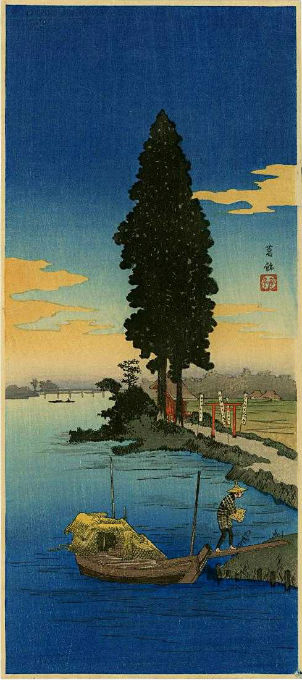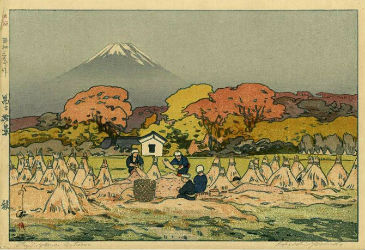
NEW YORK – Major names in 20th century Japanese printmaking are featured in a Jasper52 auction scheduled for Sunday, March 31. This online auction is composed of 125 beautiful woodblock prints by the likes of Hiroshi Yoshida, Hasui Kawase, Tokuriki Tomikichiro, Takahashi Shotei, Junichiro Sekino, Ogata Gekko, as well as Western artists who work in the Japanese tradition, such as Paul Binnie. Bid absentee or live online through LiveAuctioneers.
One of the top prints in the auction is Fujiyama Autumn by Hiroshi Yoshida (1876-1950). This oban-size first edition (above) was published by the artist in 1928. It is pencil signed by Yoshida in the lower margin. Yoshida studied Western-style painting, winning many exhibition prizes and making several trips to the United States, Europe and North Africa to sell his watercolors and oil paintings. While highly successful as a painter, Yoshida turned to woodblock printmaking upon learning of the Western world’s infatuation with the ukiyo-e art movement. He started his own workshop in 1925, specializing in landscapes inspired both by his native country and his travels abroad. Yoshida often worked through the entire process himself, designing the print, carving his own blocks and printing his work. Although he designed his last print in 1946, Yoshida continued to paint with oils and watercolors until his death in 1950.
Following World War II, Japanese artist Tomikichiro Tokuriki (1902-2000) set up his own publishing company called Matsukyu and began to teach block-carving to artisans and artists, many of them foreigners. Tokuriki designed many woodcuts of landscapes and city views in the traditional manner. The enchanting Fireflies at Uji River (below) is typical of his work. Tokuriki traveled extensively throughout the United States and Europe, and in the 1960s opened several exhibitions of his works in major U.S. cities.

Shozaburo Watanabe (1885-1962) was a major Japanese print publisher and the driving force behind the Japanese printmaking movement known as shin-hanga, or “new prints.” One of his most prolific artists was Takahashi Shotei (1871-1945), who started working for the Watanabe Color Print Co. around 1907. Shotei was among the first designers to be recruited into Watanabe’s stable of artists. Many Watanabe prints were designed for export, primarily to North America, where the demand for all things Japanese was high in the early 20th century.
By 1923 Shotei had produced nearly 500 designs for Watanabe, when Tokyo was hit by the Great Kanto earthquake — the worst recorded natural catastrophe in the history of Japan. The fires ignited by the earthquake raged for three days, and Watanabe’s print shop and all the woodblocks created by Shotei and the other early shin hanga artists were destroyed. After the earthquake, Shotei created another 250 prints mostly depicting scenic Japanese landscapes in the shin hanga style he had helped to define. He continued to work for Watanabe, but also worked with the publishers Fusui Gabo and Shobido Tanaka, where he had more control over the finished print than was possible with Watanabe. His print titled Moon Rise Nokizaki was published by Watanabe in 1936 (est. $400-$600).

Estimate: $400-$600. Jasper52 image
Junichiro Sekino (1914-1988) first exhibited with the Japanese Print Association in 1932. After World War II he created nostalgic wood block sets depicting lost customs and landscapes of Japan. In 1958, he traveled to the U. S. where he taught at Pratt Institute. In 1963, at the invitation of Gordon Gilkey, he taught at Oregon State University and also accepted an appointment to the faculty of the University of Washington. Sekino’s work is collected by the Museum of Modern Art, New York; the Art Institute Chicago; the Museum of Fine Art, Boston; the British Museum and the Portland Art Museum. He published the woodblock print titled Artist’s Nude in 1984, which is pencil signed and numbered.

Ogata Gekko (1859-1920) was a self-taught Japanese artist. Orphaned at the age of 16, Gekko survived by designing rickshaws and selling his drawings. His rickshaws were shown at the Interior Exhibition of Industrial Design as examples of fine contemporary craftsmanship. After this and after producing an immense number of paintings and sketches, he was recognized by such important figures as the artist Kawanabe Kyosai (often credited for “discovering” Gekko) and the famous Ogata family, direct descendants of one of Japan’s most celebrated artists, Ogata Korin (who was himself older brother to the legendary artist, Ogata Kenzan). Adopted by Koya Ogata, the young artist appended their family name to the name he gave himself, Gekko, which means moonlight.
Gekko was a founding member of the Bunten and a frequent prize winner at its exhibitions. He served as an illustrator during the Sino-Japanese War and many triptychs depicting battles of the war are attributed to him. He developed an amusing way of treating genre subjects after studying the ukiyo-e style on his own. Gekko was one of the earliest Japanese artists to win an international audience. Gekko’s Rabbit, 1930, is from the from the estate of Robert O. Muller, who was widely considered the most important collector in the world of 20th century Japanese prints.

Paul Binnie (b.1967) is a Scottish artist specializing in Japanese woodblock printing. His work is reflective of the shin-hanga artists of the early to mid-20th century, employing subjects such as landscapes, tattoos and beautiful Japanese women.
Binnie studied art history at Edinburgh University and painting and etching at Edinburgh College of Art from 1985 to 1990. After earning a master’s degree in 1990 he moved to Paris until his interest in Japanese ukiyo-e prints took him to Japan in 1993. There he studied woodblock printmaking as an apprentice to master printer Seki Kenji. Binnie’s Cat Feathers (Red) is a first edition woodblock print published in 2018 (est. $600-$700).

The Jasper52 Premium Japanese Woodblock Prints auction will be conducted Sunday, March 31, beginning at 1 p.m. Eastern time.
[av_button label=’View the fully illustrated catalog and bid on LiveAuctioneers.’ link=’manually,https://www.liveauctioneers.com/catalog/138051_exclusive-japanese-woodblock-prints/’ link_target=’_blank’ size=’medium’ position=’center’ label_display=” icon_select=’no’ icon=’ue800′ font=’entypo-fontello’ color=’theme-color’ custom_bg=’#444444′ custom_font=’#ffffff’ av_uid=’av-5fflitc’ admin_preview_bg=”]


